UPSC DAILY CURRENT AFFAIRS (23TH OCTOBER, 2024)
Development of Cloud Chamber as Part of Mission Mausam
Syllabus: GS 1/Geography
In News
- India is establishing a first-of-its-kind cloud chamber at the Indian Institute of Tropical Meteorology (IITM) under Mission Mausam.
| Do you know ? – Mission Mausam is led by the Ministry of Earth Sciences, and aims to enhance India’s capabilities in weather and climate science, research, and services. – The mission’s focus will include improving observations and understanding for providing highly accurate and timely weather and climate information across temporal and spatial scales, including monsoon forecasts, alerts for air quality, extreme weather events and cyclones, weather interventions for managing fog, hail, and rain, etc., capacity building and generating awareness. |
Background
- India has previously conducted experiments on cloud seeding through the Cloud Aerosol Interaction and Precipitation Enhancement Experiment (CAIPEEX), which showed that, under the right conditions, cloud seeding could enhance rainfall by up to 46%.
- However, it is acknowledged that cloud seeding alone cannot solve all rainfall issues.
What is a Cloud Chamber?
- A cloud chamber is a closed environment where water vapor and aerosols are injected under controlled humidity and temperature, allowing clouds to form.
- It will be Located at Indian Institute of Tropical Meteorology (IITM), Pune.
- It is First-of-its-kind in India, focusing on convective properties to study Indian monsoon clouds.
Relevance
- India’s cloud chamber will focus on understanding cloud physics specific to Indian weather systems, particularly monsoon clouds.
- This facility is unique as it will have convection properties, which are rare globally, allowing for detailed studies of cloud behavior under various conditions.
- It will enable scientists to study the particles that contribute to cloud formation and behavior.
Plans for Use
- Tailored Studies: Ability to adjust atmospheric parameters to simulate different environmental conditions.
- Instrumentation Development: Advanced tools will be created over the next 18-24 months to monitor cloud behavior.
- Seed Particle Injection: Techniques to test various scenarios affecting cloud formation.
Future Outlook
- Overall, the convective cloud chamber represents a significant step in advancing India’s capabilities in weather modification and research in cloud physics.
Bail Provisions Under BNSS for Undertrial Prisoners
Syllabus: GS2/Polity and Governance
Context
- The Union Ministry of Home Affairs (MHA) has advised all states and Union Territories (UTs) to implement Section 479 of the Bharatiya Nagarik Suraksha Sanhita, 2023 (BNSS), which aims to provide significant relief to undertrial prisoners.
Background
- The advisory comes amid rising concerns over overcrowded prisons and the prolonged detention of undertrial prisoners, many of whom have yet to face trial.
- India has one of the highest proportions of undertrial prisoners in the world.
- As per the National Crime Records Bureau (NCRB) Prison Statistics India 2021, over 77% of the prison population in India consists of undertrial prisoners.
- The occupancy rate of Indian prisons in 2021 was around 130%.
Reasons for overcrowded prisons
- Stringent Bail Provisions: Courts are hesitant to grant bail, particularly for minor offenses, resulting in more undertrials being imprisoned for extended periods even when they are eligible for release on bail.
- Delayed Remission and Parole: Although provisions exist for parole and remission, bureaucratic hurdles and delays in processing these requests prevent eligible prisoners from being released.
- Insufficient Prison Infrastructure: The prison capacity has not kept pace with the growing prison population.
Provisions of bail under BNSS, 2023
- Under Section 479, prisoners who have completed half the maximum imprisonment period prescribed for their alleged offense are now eligible for bail.
- The first-time offenders are entitled to release on a personal bond if they have served one-third of the maximum sentence.
e-Prisons portal
- For assisting prison authorities in quick identification of eligible prisoners, the MHA made appropriate provisions in the national e-Prisons portal enlisting the;
- Types of offenses that prisoners have been charged with,
- The maximum sentence for the offense committed,
- The date of completion of one-half or one-third of the maximum period of imprisonment specified for an offense under the relevant law by a prisoner, etc.
Other initiatives taken by government
- Model Prison Manual, 2016: Provides updated guidelines for improving prison administration with a focus on prisoners’ welfare, rehabilitation, and the protection of their rights.
- Legal Aid for Prisoners: The National Legal Services Authority (NALSA) provides free legal aid to undertrials and convicts who cannot afford legal representation.
- All India Committee on Jail Reforms (Mulla Committee) 1980: The committee recommended measures to expedite trials and decongest prisons, focus on rehabilitation and reintegration, programs for skill development, education, and mental health support for inmates.
- The Ministry of Home Affairs launched the Support for Poor Prisoners’ Scheme in 2024, allocating ₹20 crore to provide financial assistance to poor prisoners who are unable to afford bail or sureties.
Way Ahead
- Fast-track Courts: Expanding fast-track courts for quicker disposal of cases, especially for undertrial prisoners, will reduce their prolonged detention.
- Leveraging technology for e-filing, virtual hearings, and automated case management to reduce delays in court processes.
- Undertrial Review Committees (URCs): Strengthening URCs at the district level to regularly review the status of undertrial prisoners and expedite their release where appropriate, especially for petty offenses.
India and China Reach Breakthrough Agreement on Border Tensions
Syllabus: GS2/International Relation
Context
- India and China have reached an agreement on the “patrolling arrangements” and the resolution of themilitary stand-off at the Line of Actual Control (LAC).
- It includes the remaining friction points of Demchok and Depsang.
About
- After the beginning of the stand-off in eastern Ladakh in 2020, India and China had deployed thousands of troops in forward posts along the LAC.
- After negotiations were held in a variety of forums, agreement has been arrived at leading to resolution of the issues.
- Certain mutual agreements have also been made for the eastern theatre, especially in the sensitive sectors of Arunachal Pradesh.
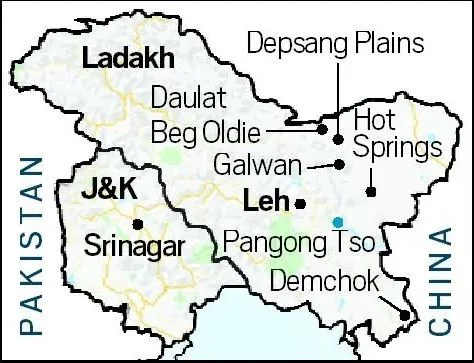
The India-China Borders
- India considers the LAC to be 3,488 km long, while the Chinese consider it to be only around 2,000 km.
- It is divided into three sectors: the eastern sector which spans Arunachal Pradesh and Sikkim, the middle sector in Uttarakhand and Himachal Pradesh, and the western sector in Ladakh.
- Western Sector or Aksai Chin Sector: The region is claimed by the Chinese government post-1962 war as an autonomous part of the Xinjiang region which was originally a part of the Indian state of Jammu and Kashmir.
- Middle Sector: It is the less disputed section of the Indo-China border but the recent Doklam standoff and Nathu La Pass trading issues have brought distress at all levels.
- Eastern Sector or Arunachal Pradesh:McMahon Line had differentiated India and China in this sector but in the 1962 war the People’s Liberation Army covered 9000 sq. km. area.
- The announcement of a unilateral ceasefire made them step back on the international borderline.
- However, China has been claiming that area as their own and recently they have started to claim the whole of Arunachal Pradesh as their own.
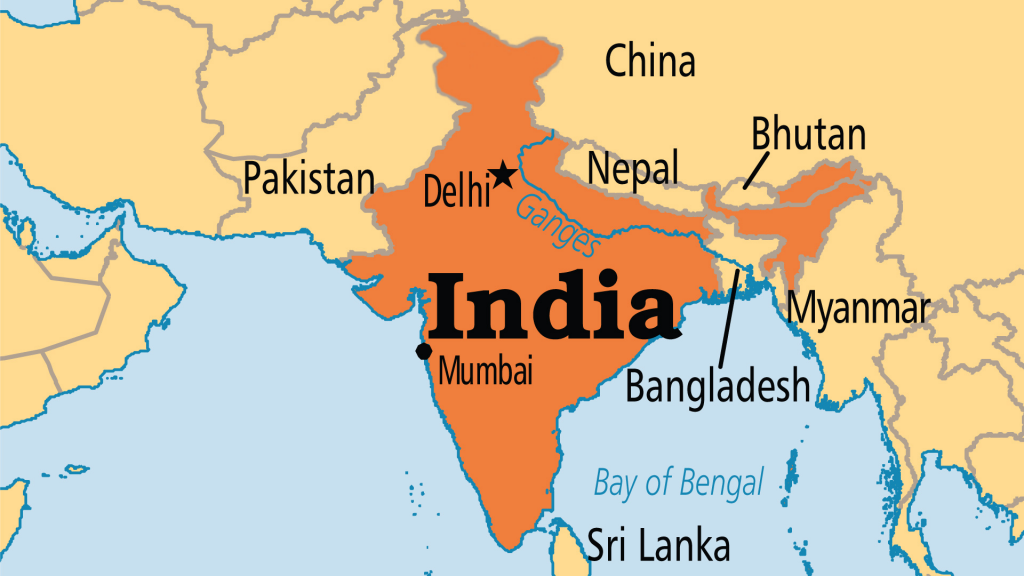
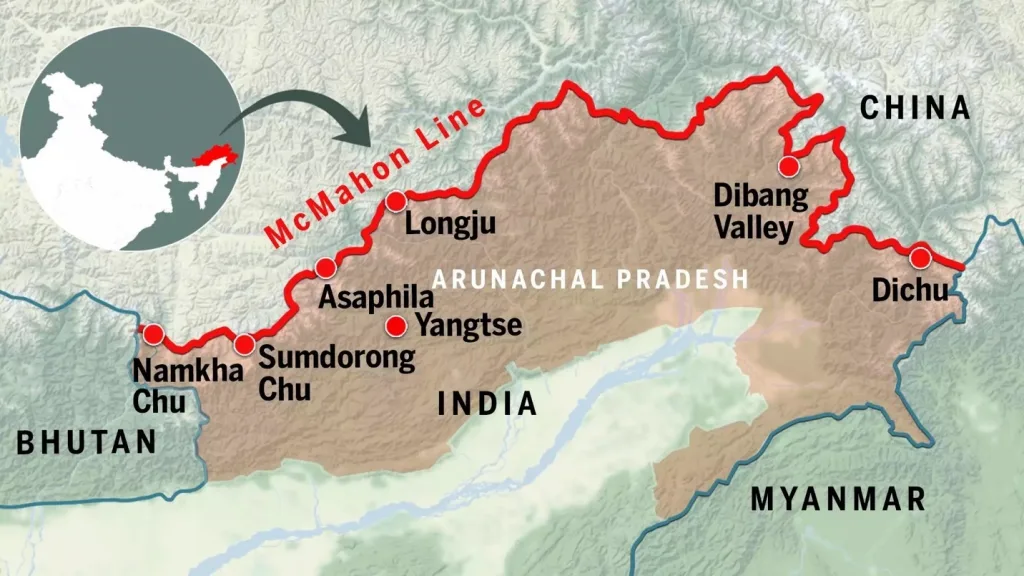
Why did China Encroach on Indian Territory?
- To show its dominance: China felt that somehow India was not recognising the growing gap in their relative economic status, when China perceived that India was seeking to get closer to the United States (US) to balance China it decided that it needed to demonstrate its power.
- From the Chinese point of view, the basis of this “stability” does not come from settling its border issues with India, but dominance on the border and deterring Indian challenges.
- India’s stand on China’s Aggressive Foreign Policy: India sought to challenge the Chinese point of view in many ways.
- By building up its border infrastructure to more effectively maintain a deterrence capacity against the PLA along its borders.
- By developing a relationship with the US which appeared to merge the threats from China’s primary and secondary strategic directions.
- By promoting its ties with exiled Tibetans and maintaining its relationship with the Dalai Lama.
- Challenging China’s efforts to develop ties in South Asia and the Indian Ocean region.
- Leading the global critique of China’s Belt & Road Initiative.
- Threat to Chinese efforts in the South-Asian region: China needs to be accepted in its periphery as the foremost economic and military power, before it is taken seriously as a global power.
- In its southwest is India, equally huge and populous and with aspirations of its own, and its neighbors most certainly see India as being the naturally pre-eminent power in South Asia.
- India’s engagement with Chinese Adversaries: In recent years, India has developed strong military ties with the country which China believes is its primary threat, the United States.
- China would like to focus on the western Pacific challenge and retain stable ties with India in South Asia.
- India’s constant efforts, however, to upgrade its border infrastructure and strengthen its partnership with the US destabilise China’s calculations.
Way Forward
- Disengaging from the points of friction is undoubtedly a step forward, and India and China must go a long way to solve the border dispute.
- India should continue to press for complete disengagement and de-escalation from all friction areas.
- Also, the Corps Commanders level talks must continue as the relationship cannot go back to normal as long as the situation along the stand-off lingers.
- India must keep its stand firm over restoring the status quo and rebuilding peace all along the LAC.
- The Indian government must constantly watch all developments that affect India’s security and take all essential measures to safeguard its sovereignty and territorial integrity.
COP 16 of Convention on Biological Diversity
Syllabus: GS3/ Environment
Context
- The Sixteenth meeting of the Conference of the Parties to the Convention on Biological Diversity (CBD COP 16) will be held in Cali, Colombia.
Convention on Biological Diversity
- Origin: The Convention was opened for signature in 1992 at the United Nations Conference on Environment and Development (Rio Earth Summit).
- The Convention on Biological Diversity (CBD) entered into force on 29 December 1993.
- The first session of the COP was scheduled in 1994 in the Bahamas.
- Secretariat: Montreal, Canada.
- Ratification: The CBD has been ratified by 196 nations, making it one of the most widely adopted international treaties.
- The United States is the only UN member state that has not ratified the convention.
- It has 3 main objectives;
- The conservation of biological diversity
- The sustainable use of the components of biological diversity
- The fair and equitable sharing of the benefits arising out of the utilization of genetic resources.
- Governing body is the Conference of the Parties (COP), which meets every two years.
Supplementary Agreements of CBD
- Cartagena Protocol on Biosafety: This international treaty governs the transboundary movements of living modified organisms (LMOs) resulting from modern biotechnology, ensuring that countries can manage risks associated with biotechnology.
- It was adopted in 2000 and entered into force in 2003.
- Nagoya Protocol: This agreement focuses on Access to Genetic Resources and the Fair and Equitable Sharing of Benefits arising from their utilization (ABS), aimed at ensuring that benefits derived from genetic resources are shared fairly with the countries of origin.
- It was adopted in 2010 and entered into force in 2014.
| Kunming-Montreal Global Biodiversity Framework – The Kunming-Montreal Global Biodiversity Framework was concluded at COP15 of the Convention on Biological Diversity (CBD), held in Montreal, Canada, in 2022. – This framework is a landmark agreement aimed at addressing the global biodiversity crisis. – It features 23 targets to be met by 2030 and four global goals to preserve biodiversity for current and future generations. – The agreement is not binding on members. |
Momentum for 30 x 30
- One of the main objectives of COP16 is to expedite progress on the 30 x 30 targets which are the most immediate.
- It is a commitment to put at least 30% of the world’s lands and oceans, especially biodiversity rich areas, under conservation by 2030, and to initiate restoration work in at least 30% of degraded land or marine ecosystems by 2030.
Way Ahead
- Implementation Gaps: Identifying and overcoming challenges in the implementation of existing biodiversity agreements.
- Equitable Access: Ensuring equitable access to genetic resources and fair sharing of benefits derived from their use.
- Monitoring and Reporting: Establishing effective mechanisms for monitoring and reporting on biodiversity targets.
Fourth Global Coral Bleaching Event
Syllabus: GS3/ Biodiversity and Conservation
Context
- According to the National Oceanic and Atmospheric Administration (NOAA), the mass bleaching of coral reefs around the world since 2023 is now the most extensive on record.
About
- 77% of the world’s coral reef areas – from the Atlantic to the Pacific to the Indian oceans – have so far been subjected to bleaching-level heat stress.
- The NOAA coral reef authority declared the global bleaching event in 2024, making it the fourth of its kind since 1998.
- Mass bleaching events on the Great Barrier Reef have been documented with full-scale surveys in 1998, 2002, 2016, 2017, 2020, 2022 and 2024.
- The previous record from the 2014 to 2017 mass bleaching affected just below 66 percent of the world’s reef area.
- In coming months and years scientists will conduct underwater assessments of dead corals to help tally up the severity of the damage.
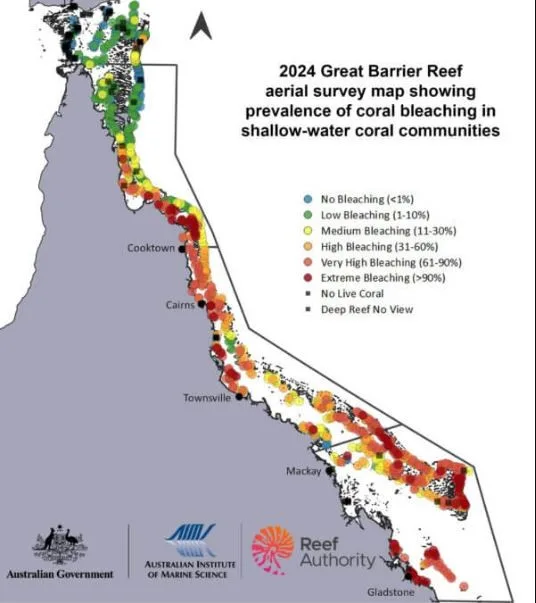
What are Corals?
- Corals are invertebrates that belong to a large group of animals called Cnidaria.
- Corals are formed by multiple small, soft organisms known as polyps.
- They secrete a rocky chalk-like (calcium carbonate) exoskeleton around themselves for protection.
- Coral reefs are therefore created by millions of tiny polyps forming large carbonate structures.
- Appearance: Corals range in colour from red to purple and even blue, but are most commonly shades of brown and green.
- Coral are bright and colorful because of microscopic algae called zooxanthellae.
- There are three types of coral reefs – fringing reefs, barrier reefs and atolls.
- Fringing reefs form along shorelines, barrier reefs form in open water and atolls are circular reefs that have formed around sunken volcanoes.
- Significance: They provide food, shelter, resting and breeding grounds to a quarter of all marine life, acting as nurseries and refuges to protect critical biodiversity.
- They also support more than 1 billion people living in coastal regions around the world by providing food, livelihoods and recreation.
Coral Bleaching
- Coral bleaching occurs when corals expel the colourful algae living in their tissues.
- Without these helpful algae, the corals become pale and are vulnerable to starvation and disease.
- A bleached coral is not dead, but ocean temperatures need to cool off for any hope of recovery.
- At least 14% of the world’s remaining corals were estimated to have died in the previous two global bleaching events.
- Scientists had previously projected that coral reefs would cross a tipping point at 1.5 degrees Celsius (2.7 F) of global warming, whereby up to 90% of reefs would be lost.
- The latest record bleaching adds to growing evidence that reefs have already passed a point of no return at just 1.3 C (2.3 F) of warming.
What triggers Coral Bleaching?
- The leading cause of coral bleaching is climate change.
- A warming planet means a warming ocean, and a change in water temperature—as little as 2 degrees Fahrenheit—can cause coral to drive out algae.
- Coral also bleaches for other reasons, like extremely low tides, pollution, or too much sunlight.
- The ongoing bleaching has been made worse by El Nino, a natural climate pattern that can temporarily warm some oceans, which ended in May.
Concerns
- Coral bleaching matters because once these corals die, reefs rarely come back.
- With few corals surviving, they struggle to reproduce, and entire reef ecosystems, on which people and wildlife depend, deteriorate.
- This would have dire implications for ocean health, subsistence fisheries and tourism.
Impact of Coral Bleaching
- Wildlife: Thousands of marine animals depend on coral reefs for survival.
- Coral reefs provide shelter, spawning grounds, and protection from predators.
- They also support organisms at the base of ocean food chains.
- As reef ecosystems collapse, already at-risk species may face extinction.
- Humans: Coral reefs are natural barriers that absorb the force of waves and storm surges, keeping coastal communities safe.
- Every year, reefs provide about $2.7 trillion in goods and services, according to a 2020 estimate by the Global Coral Reef Monitoring Network.
- Bleached coral also compounds the overfishing crisis by removing links in the food web and depriving some fish of a place to spawn and develop.
- Reef tourism brings in billions of dollars each year and supports thousands of jobs.
Can corals recover from bleaching?
- Corals can recover from bleaching over time, but only if temperatures drop and conditions return to normal.
- When this happens, the algae returns and the corals gradually regain their health.
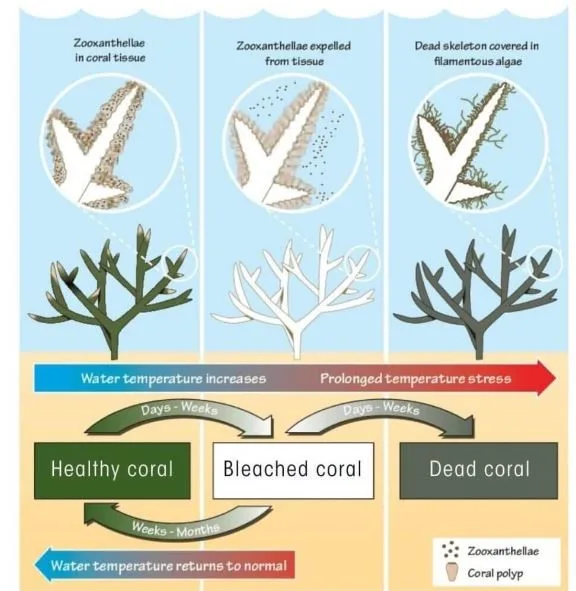
Way Ahead
- Strengthening Marine Protected Areas (MPAs).
- Implementing coral restoration techniques, such as coral gardening and breeding resilient coral species, to enhance recovery after bleaching events.
- Advocating for global efforts to reduce greenhouse gas emissions to limit temperature increases and ocean acidification.
- Increasing investment in research to better understand coral resilience, bleaching triggers, and recovery processes, alongside developing advanced monitoring technologies.
FACTS IN NEWS
Atlantic Meridional Overturning Circulation (AMOC)
Syllabus: GS1/ Physical Geography
In News
- Scientists have issued a stark warning about the potential collapse of the Atlantic Meridional Overturning Circulation (AMOC).
About
- The collapse of the AMOC could have “devastating and irreversible” impacts, particularly on Nordic countries (Denmark, Iceland, Norway, Finland, and Sweden).
- These regions would experience extreme weather changes, including significant cooling and southward shift of tropical monsoon systems, disrupting agriculture and ecosystems globally.
Atlantic Meridional Overturning Circulation (AMOC)
- The AMOC is a large system of ocean currents.
- It is the Atlantic branch of the ocean conveyor belt or Thermohaline circulation (THC).
- THC is a part of the large-scale ocean circulation that is driven by global density gradients created by surface heat and freshwater fluxes.
- AMOC distributes heat and nutrients throughout the world’s ocean basins.
- It carries warm surface waters from the tropics towards the Northern Hemisphere, where it cools and sinks.
75 years of Bharatiya Adim Jati Sevak Sangh
Syllabus: GS1/ History
Context
- President Droupadi Murmu attended an event on the completion of 75 years of the Bharatiya Adim Jati Sevak Sangh in New Delhi.
Bharatiya Adim Jati Sevak Sangh
- It was established on October 24th, 1948 in Delhi by Thakkar Bapa (Amritlal Vithaldas Thakkar), with the objective of promoting the welfare of the tribal and marginalized communities in India.
- Dr. Rajendra Prasad, was designated as the Founder-President of BAJSS.
- It works on issues like poverty, illiteracy and poor health prevalent in the tribal society.
Thakkar Bapa
- Amritlal Vithaldas Thakkar, also known as Thakkar Bapa, was born on 29 November 1869 in Bhavnagar, Gujarat.
- He was a prominent social reformer, freedom fighter, and humanitarian, renowned for his dedication to the upliftment of tribal and marginalized communities in India.
- Early life: He worked as an engineer for several years in India and abroad. Later he was inspired by Mahatma Gandhi and the values of truth and non-violence.
- Contribution to freedom struggle: Thakkar Bappa joined India’s freedom struggle and became an ardent advocate for the welfare of underprivileged communities.
- In 1918, he played a crucial role in presenting the Compulsory Primary Education Bill to the Bombay Legislative Council.
- Thakkar Bappa was actively involved in setting up the Harijan Sevak Sangh in 1932.
- Literary work: He authored the book, Tribes of India, published in 1950.
Kartarpur Corridor
Syllabus: GS2/IR
Context
- India and Pakistan agreed to renew their agreement to operate the Kartarpur Corridor to facilitate pilgrims from India to visit the Kartarpur Sahib Gurudwara for another five years.
About
- The agreement was signed in 2019 and was operationalised for the 550th birth anniversary of Guru Nanak, the founder of Sikhism and the first of the ten Sikh Gurus.
- It provides for visa-free travel of Indian pilgrims, as well as Overseas Citizen of India (OCI) cardholders, from India on a daily basis, throughout the year, however, all pilgrims are required to return the same day.
- There is no restriction on the faith of the pilgrims who travel through the corridor.
What is the Kartarpur Corridor?
- It serves as a visa-free border crossing and religious corridor, linking the Gurdwara Darbar Sahib Kartarpur in Pakistan to Gurdwara Dera Baba Nanak in Punjab.
- The Indian part of the corridor involves a 4.1-km-long, four-lane highway from Dera Baba Nanak to the international border.
- Pakistani Sikhs do not have access to this corridor and cannot visit Dera Baba Nanak in India without first obtaining an Indian visa.
Third Phase of the Amazon Future Engineer Program
Syllabus: GS2/ Governance
Context
- National Education Society for Tribal Students (NESTS) launched the Third Phase of the ‘Amazon Future Engineer Program’.
About
- The Future Engineer Programme serves as a stepping stone in creating Computer awareness for the tribal students of Eklavya Model Residential Schools (EMRS).
- The Program was launched in 50 EMRSs spread across Andhra Pradesh, Gujarat, Karnataka, Madhya Pradesh, Odisha, Telangana and Tripura.
- The third phase would include an orientation on blockchain, artificial intelligence, coding, block programming and AI sessions.
National Education Society for Tribal Students (NESTS)
- NESTS fosters technological literacy and modernizing education for tribal students across the nation.
- Through the capacity-building programs, NESTS aims to ensure that tribal students are well-prepared for future careers in STEM fields, contributing to India’s technological advancement.
Section 6A of the Citizenship Act, 1955
Syllabus :GS 2/Governance
In News
- The Supreme Court upheld the constitutional validity of Section 6A of the Citizenship Act, 1955.
Section 6A
- It originates from the Assam Accord signed in 1985, establishing a framework for citizenship based on the cut-off date of March 25, 1971, which marked the onset of the Bangladesh Liberation War.
- Under it, Migrants of Indian origin entering Assam before January 1, 1966, are granted citizenship, while those arriving between January 1, 1966, and March 24, 1971, receive citizenship rights except voting for ten years.
- Individuals entering after March 25, 1971, are classified as foreigners and subject to deportation.
Challenge to Section 6A
- Petitioners argued that the cut-off date is discriminatory, violating Article 14 (right to equality) and inconsistent with Articles 6 and 7, which govern citizenship related to Partition-era migration.
- They claimed it disrupts the demographic balance and infringes on the cultural and linguistic rights of indigenous populations, invoking Article 29.
Majority Ruling
- The majority upheld the differentiated treatment for Assam, citing its unique historical context.
- Justices stated that the provision does not violate Article 14, balancing humanitarian considerations with the impact of mass migration on Assam’s resources.
- They clarified that Section 6A is not inconsistent with Articles 6 and 7, as it addresses individuals not covered by those provisions.
- The majority interpreted Article 29 to allow coexistence of cultures and noted grievances may stem from inadequate enforcement of deportation of illegal immigrants.
Dissenting Opinion
- Justice Pardiwala found Section 6A unconstitutional, arguing it has failed to curb illegal migration and lacks a sunset clause, leading to demographic imbalances.
- He criticized the provision for not allowing self-identification as a foreigner, making detection reliant on state intervention, which deviates from the principles of the Citizenship Act.
Cobenfy: New drug for Schizophrenia
Syllabus :GS 3/Science and Technology
In News
- The U.S. Food and Drug Administration (FDA) approved Cobenfy, a new drug for treating schizophrenia, which combines xanomeline and trospium chloride.
Schizophrenia
- Schizophrenia is a serious psychiatric disorder affecting about 1% of the population, often leading to social isolation and a significantly reduced life expectancy.
- Causes : The disorder is multifactorial, with strong genetic links and environmental factors. Key points include:
- Genetic risk factors identified through genome-wide association studies.
- Neurodevelopmental influences, such as prenatal complications, can significantly increase risk.
- Symptoms typically begin in late adolescence or early adulthood, and include:
- Prodromal Symptoms: Feelings of change, anxiety, social withdrawal.
- Clinical Symptoms: Divided into positive symptoms (delusions, hallucinations), negative symptoms (apathy, reduced emotional expression), and disorganization (thought disorder, inappropriate behavior).
- Effect: Cognitive Impairments:
- Treatment : The approval of Cobenfy marks a significant development in schizophrenia treatment, providing a new option with a different mechanism of action.
- Cobenfy is a combination of xanomeline and trospium chloride.
- Xanomeline: A muscarinic receptor agonist potentially beneficial for all schizophrenia symptoms.
- Trospium Chloride: An antimuscarinic agent that helps mitigate xanomeline’s side effects.
- Cobenfy’s common side effects include nausea, indigestion, hypertension, tachycardia, and dizziness
Fourth nuclear-powered Ballistic Missile Submarine
Syllabus: G3/Defence
Context
- India’s fourth nuclear-powered ballistic missile submarine (SSBN), referred to as S4* was launched in Visakhapatnam.
About
- India currently has two SSBNs operational.
- INS Arihant was commissioned into service in 2016.
- The second SSBN, INS Arighaat (S3) was commissioned in August 2024.
- The 3rd SSBN Aridhman (S4) is currently undergoing sea trials and is expected to be commissioned into service next year.
Aridhman (S4)
- It has nearly 75% indigenous content and is equipped only with 3,500 km range K-4 nuclear ballistic missiles, which can be fired through vertical launching systems.
- With unlimited range and endurance, the SSBN is constrained only by food supplies, crew fatigue and maintenance.
- The Indian Navy continues to modernize and expand its submarine fleet to meet evolving security challenges and enhance its maritime capabilities.
Discovery of New Genus of Jumping Spiders ‘Tenkana’
Syllabus :GS 3/Environment
In News
- A team of arachnologists has identified a new genus of jumping spiders named Tenkana, found across southern India.
Tenkana
- The genus name, derived from the Kannada word for “south,” reflects its geographic range, which spans southern India and northern Sri Lanka.
- Tenkana spiders belong to the Plexippina subtribe and differ from related genera like Hyllus and Telamonia. Unlike their forest-dwelling relatives, Tenkana spiders prefer drier habitats and ground areas, being found in states such as Tamil Nadu, Puducherry, Karnataka, Telangana, and Andhra Pradesh.
- The new species, Tenkana jayamangali, was discovered in Karnataka and named after the Jayamangali river, its initial sighting location.
- Two speciespreviously categorized under the genus Colopsus—
- Tenkana manu and Tenkana arkavathi—have now been reclassified into the new genus.
- The former was named in honor of Dr. Manu Thomas, a retired professor, in 2014.
- Tenkana manu and Tenkana arkavathi—have now been reclassified into the new genus.
5th National Water Awards
Syllabus: Miscellaneous
Context
- The President of India, conferred the 5th National Water Awards in New Delhi.
About
- The National Water Awards focus on the good work and efforts made by individuals and organizations across the country in attaining the government’s vision of a Jal Samridh Bharat.
- The Awards were introduced in 2018 by the Ministry of Jal Shakti, and first were given in 2019.
- The awards were presented to 38 winners in nine categories including Best State, Best District, Best Village Panchayat, Best Urban Local Body, Best Water User Association and Best Civil Society.
- Winners in best District category;
- Banda (Uttar Pradesh) from North Zone and Ganderbal (J&K) from north zone (joint winner),
- Indore (Madhya Pradesh) from west zone,
- Visakhapatnam (Andhra Pradesh) from south zone,
- Balangir (Odisha) from east zone
- Dhalai (Tripura) from the North East zone.
Spraying Diamond dust to cool Earth
Syllabus: GS3/Environment/Science and Technology
Context
- A new study has argued that spraying millions of tonnes of diamond dust in the Earth’s upper atmosphere every year could help cool down the Earth and combat global warming.
About
- Several other compounds, such as sulphur, calcium, aluminium, and silicon, have been suggested previously for doing the same job.
- The central idea here is to scatter material that can reflect solar radiation into Space and prevent it from reaching Earth, thereby cooling down the planet.
- The installation of space-based mirrors has also been proposed.
- Such solutions, called geo-engineering (more specifically solar radiation management), have been under study for quite some time, though they have never been tried.
Geoengineering
- Geoengineering refers to any large-scale attempt to alter the Earth’s natural climate system to counter the adverse impacts of global warming.
- Solar Radiation Management (SRM), in which materials are proposed to be deployed in Space to reflect incoming solar rays and prevent them from reaching Earth, is one of the two broad geoengineering options being explored.
